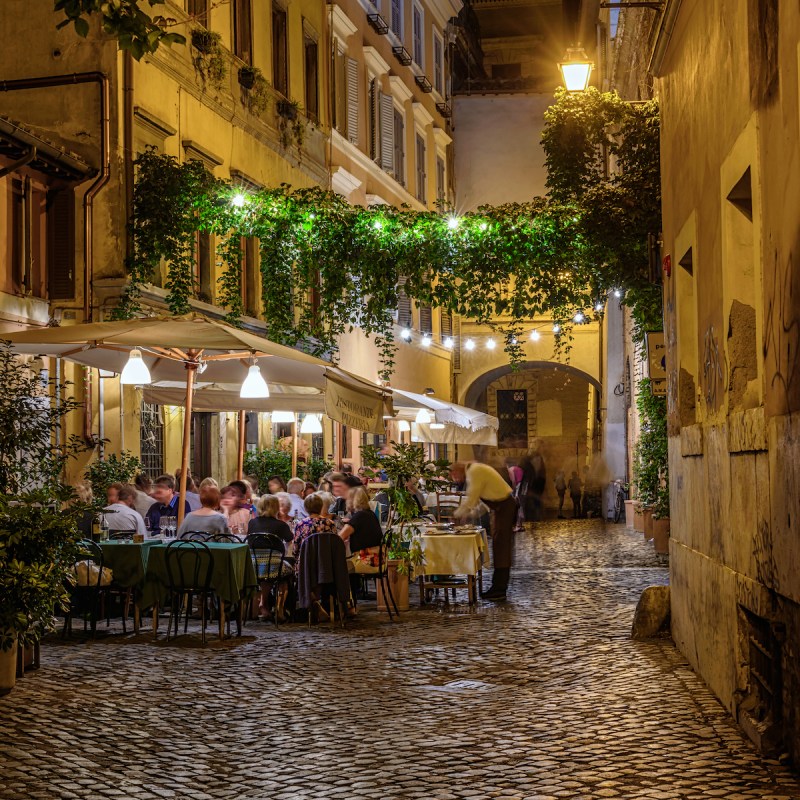
My first experience with tours in Rome was a VIP Colosseum At Night Tour with Walks City Experiences Tours. The guide was not only knowledgeable, but delivered historical facts with wry humor that made the tour all the more memorable.
Since I had not been in Rome in many years, I decided a great way to reconnect was to reach out to Walks for a food tour in my favorite neighborhood, Trastevere. Walks now partners with Devour Tours, a company that prides itself on connecting curious travelers to the unique history of a place through its cuisine.
Devour Tours was founded in 2012 to help support struggling eateries during the recession. I liked their ethos and I’d already had a good experience with their partner. I booked the Trastevere Gourmet Food And Wine Tour. This turned out to be a good choice because even though many things in Trastevere had not changed since I was last there, the food and wine scene has evolved.
My tour was hosted by Devour Tours, but as always, all opinions are my own.

1. Learn Some History
While most people would probably cite tasting delicious foods as the number one reason to take a food tour, I love learning all the history and details about the food, the wine, and the neighborhood. At each place we visited, we learned about how the food was made, where the recipe originated, and about the current owners.
Our guide, Mattia, who joined Devour when they relaunched after the pandemic, gave us some background on the history of Trastevere. Trastevere (which means across the Tiber), is a neighborhood of Rome not far from the historic center. He explained that it has not always been a part of Rome. The area was captured by the Romans from the Etruscans roughly between 753-509 B.C. in order to gain control of the waterway on both sides of the river. Historically, it was an area for outsiders.
Our tour met in Piazza San Cosimato, which Mattia referred to as the local’s piazza. I recall on my many trips to Rome spending a lot of time there just hanging out, watching the kids kick balls, having a drink at a sidewalk table, and also shopping at the outdoor produce market.

2. Discover A Family-Owned Enoteca
La Vite
The first place we visited was La Vite, a small enoteca owned by Giulia who took over the management from her father; collectively they have owned the enoteca for 33 years. Inside La Vite, the atmosphere is casual and warm with a beautiful wooden bar.
Giulia keeps a small but interesting selection of wines, mostly organic and natural. Most of the wines are available by the glass, and the daily menu is written on a chalkboard. We tried a prosecco made in a natural method which simply means the grapes and wine were prepared without chemicals and the fermentation used native yeast. Giulia paired our wine with a prosciutto, grissini, and friarelli.
Our group of about eight Americans had not heard of friarielli, though it looked familiar. Friarelli is called “broccoli rabe” in the U.S. This marinated version was delicious, and I couldn’t believe I’d missed out on it all these years. Friarelli is sauteed in olive oil and garlic. Yum!
We also learned that the prosciutto is made in a style invented at the end of the Roman era. The meat is dry-salted and cured, then hung to dry and lightly smoked. It is a style from the nearby Umbria region. Grissini is a skinny, crunchy breadstick. You’ve probably had them served in a paper wrapper.

3. Visit Iconic Places
Bar Calisto
Bar Calisto in Trastevere’s Piazza Santa Maria has been a popular meeting place for tourists and locals alike for over 50 years. Everyone goes there, and it’s busy all day from opening to closing at 2:00 a.m. It’s not fancy, but that’s part of the charm.
Our group arrived during apertivo hour, which is extremely busy, but honestly, that’s just the norm. Here we tried one of the most iconic Italian cocktails, a spritz. Our options were either Aperol or Campari spritz. The Campari version is bitter, and the Aperol is bittersweet. A spritz is made with prosecco and a bit of sparkling water — plus the apéritif — and is sometimes garnished with a slice of orange. Aperol Spritz is a bit ubiquitous these days but they are very refreshing.
Mattia gave us some of the colorful background on Bar Calisto as we sipped our spritz. We learned that there’s usually a group of older men who play chess outside and refuse to acknowledge that their bar is now a hipster hangout. It was always hip, but don’t tell them that. Bar Calisto is a must.

4. Experience The Local Foods
Osteria Ferrara
At Osteria Ferrara — a pretty, upscale restaurant — we tried two of Rome’s most loved dishes paired with local wine, of course. The first appetizer was fried zucchini flowers with sardines paired with a white wine from Lazio. As the main course, we had Amatriciana pasta. We also had fried gnocchi, a signature starter at Ferrara. It’s made with carbon which gives it a smokey color. The carbon didn’t really add much in terms of taste but did add to the color and texture which was a bit crunchy with a light buttery flavor. Overall, our group gave it a thumbs up.
Zucchini flowers, or fiori di zucca, belong to the Roman tradition of frying, and it seems its origin is hidden in the ancient Jewish Roman families. The real recipe of this dish — which can be considered one of the most common Roman street-food — is based on frying the flowers (very fresh!) stuffed with fior di latte cheese (mozzarella) and anchovy in plenty of boiling oil. When you bite a fried zucchini flower, it should almost melt in your mouth, but also crack: a divine sensation!
Our main course was Amatriciana, which is made with tomatoes, pork cheek, and pecorino cheese. I remember the first time I went to Rome, I asked for something very typically Roman and that is what they served me. Amatriciana takes its name from the nearby town of Amatrice (which recently suffered a terrible earthquake) where it’s said to have originated.
Pro Tip: Amatriciana is delicious and also very rich. Many of us were unable to finish it after all the other food we had tried.

5. ‘Bar,’ ‘Cafe,’ Enoteca, And Osteria Explained
What’s the difference between a bar and an enoteca? In Italy, a bar is a place that is open all day and that serves coffee, alcohol, and snacks. Beer and wine bars are called birreria and enoteca respectively. Osterias only served wine until the last 30 years or so. They were meant to be casual places without a menu. As we walked, Mattia also shared how to know if a place is good or not. This is really useful information because there are so many in Trastevere, but you can use this knowledge anywhere in Rome.

6. Learning About Wine And Food Pairing
La Latteria
La Latteria is a delightful place serving a serious wine list. The owner is from Sardinia but sources from small producers across Italy. La Latteria serves mostly cheese and meats but also offers some hot food items.
We tried three different bruschettas and two Italian wines — one red wine and one white wine. Mattia filled us in on the wines such as where they were from and production notes — both were natural wines. We tried tasting each bruschetta with both wines to see how they paired. This was not meant to be a technical or strict wine-tasting event, it was just informative and fun.
The three bruschettas were bruschetta with olive oil and salt, bruschetta with Fiore di Pecorino Sardo (a sheep mild cheese with a very pungent flavor), and Ciauscolo — a mix of meats, bacon, ham, the loin, and the shoulder. It is aged at least 15 days. The third bruschetta was topped with an Italian cheese from Puglia made from pulled mozzarella curds mixed with heavy cream. It was so fresh and delicious that we were all licking our fingers.
7. A Chance To Discover One Of Rome’s Oldest Neighborhoods
Ferrara was our last stop and a delicious end to the evening. The tour lasted 3 hours, but we all agreed the time flew by. We all discovered some new favorite restaurants. Most of the group had never been to Trastevere at all, so for them, it was also a chance to learn about one of Rome’s most interesting and popular neighborhoods. For me, it was a walk down memory lane.
Would I recommend a tour with Devour? Absolutely. It was fun, the group was small enough that we could all talk to each other, our guide was excellent, and the choice of places to visit gave us a good overview of what Trastevere has to offer.
